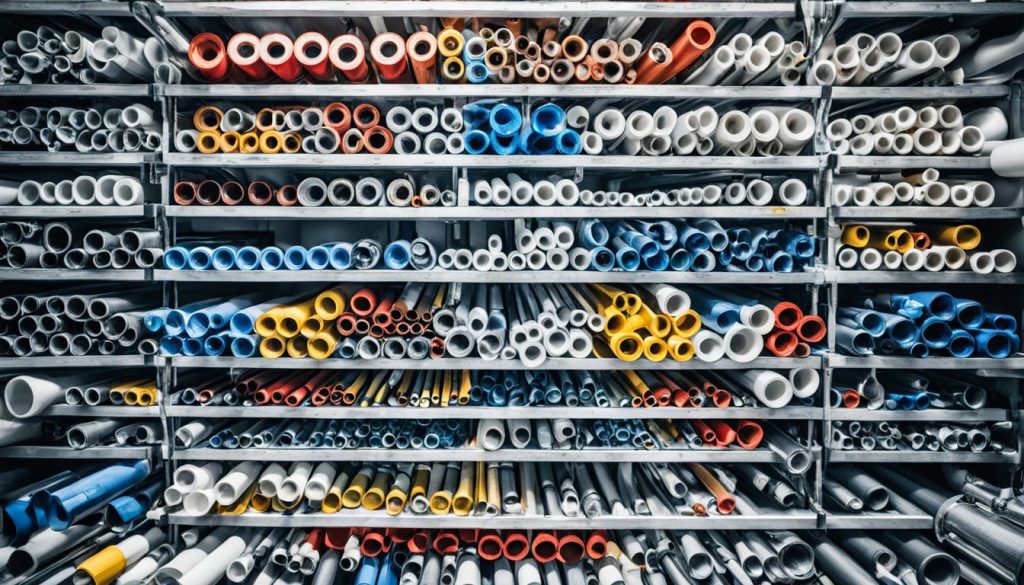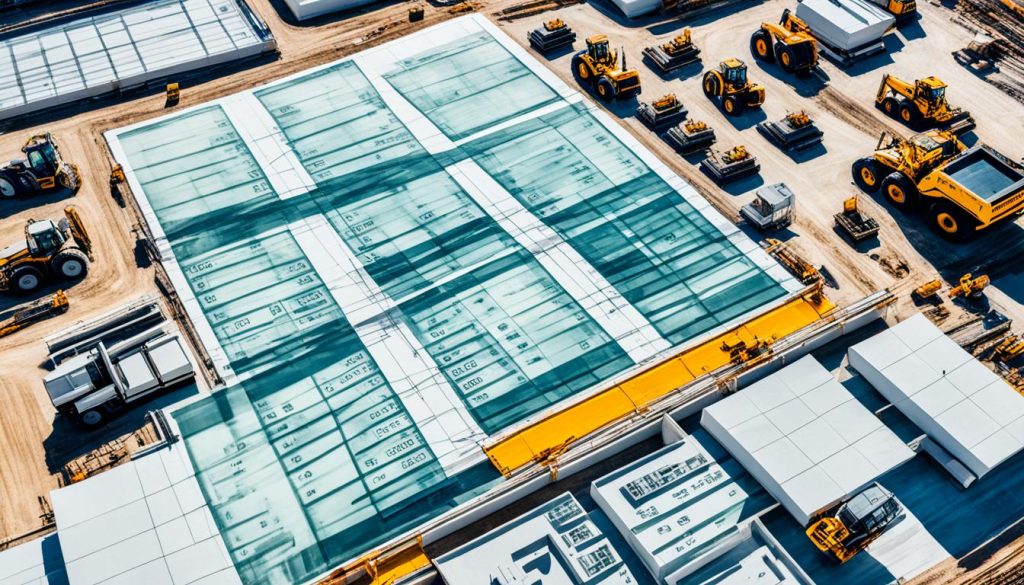New Construction Plumbing Rough-In Cost Guide
Did you know that the cost of new construction plumbing rough-in can account for up to 15% of the total construction budget?
When building a new home or commercial property, it’s important to have a thorough understanding of the costs involved in plumbing rough-in. From labor and materials to overhead expenses and design complexity, each factor impacts the overall expense of the project.
Key Takeaways:
- Labor costs are the largest component of new construction plumbing rough-in expenses.
- Material costs include pipes, fittings, valves, and fixtures.
- Overhead costs encompass insurance, utilities, equipment, and office expenses.
- Markup and contingency help ensure profitability.
- Location factors and design complexity can influence the overall cost.
Labor Costs
In any new construction plumbing rough-in job, labor costs are typically the most significant part of the total cost. It includes the hours spent by the plumbing team in planning, preparing, and executing the job. The cost of labor can vary depending on the region and the level of expertise required.
The industry standard approach to pricing labor is estimating the total number of hours needed for the job and multiplying it by the hourly rate.
Factors that can influence labor costs include:
- The complexity of the project
- The level of skill and expertise required
- The geographic location
Plumbing professionals should carefully consider these factors when determining their pricing and ensuring that their rates are competitive.
Material Costs
When estimating the cost of a plumbing rough-in job for new construction, it’s essential to consider the material costs. Material costs include pipes, fittings, valves, fixtures, and other necessary supplies for the project. Working with trusted suppliers is crucial to ensure quality materials at competitive prices. Building strong relationships with suppliers can also lead to discounts and better terms, which can positively impact the overall pricing of the job.
Using high-quality materials is important for the longevity and efficiency of the plumbing system. Investing in durable pipes, reliable fittings, and efficient fixtures can save costs in the long run by reducing the need for repairs and replacements.
Here is an example of how material costs can vary:
| Material | Quantity | Unit Price | Total Cost |
|---|---|---|---|
| Pipes | 200 feet | $3.50 per foot | $700 |
| Fittings | 30 pieces | $8.00 per piece | $240 |
| Valves | 6 pieces | $15.00 per piece | $90 |
| Fixtures | 5 pieces | $150.00 per piece | $750 |
It’s essential to calculate the precise material costs for each project based on the specific requirements and quantities needed. By accurately accounting for material costs, plumbers can provide transparent pricing to their clients and ensure a fair and competitive estimate.
Working with reputable suppliers and carefully selecting materials can contribute to the overall success and customer satisfaction of the plumbing rough-in job.
Overhead Costs
Running a plumbing business involves more than just labor and material costs. There are also indirect expenses, known as overhead costs, that need to be taken into account. These costs include insurance, utilities, equipment, licensing fees, and office expenses.
Calculating overhead costs is essential for determining the true cost of each plumbing job and ensuring a profitable business. To determine the per-job overhead cost, these expenses should be calculated annually and divided by the number of new construction plumbing rough-ins expected to be completed in a year.
Let’s take a closer look at the various components of overhead costs:
| Expense | Description |
|---|---|
| Insurance | Includes general liability insurance, workers’ compensation insurance, and vehicle insurance. |
| Utilities | Covers expenses for electricity, water, gas, and other utilities necessary to operate the plumbing business. |
| Equipment | Includes the cost of purchasing, maintaining, and repairing plumbing tools, machinery, and vehicles. |
| Licensing fees | Refers to the costs associated with obtaining and renewing plumbing licenses and certifications. |
| Office expenses | Encompasses rent, office supplies, communication services, software subscriptions, and other administrative costs. |
By factoring in overhead costs when bidding for a new construction plumbing rough-in job, plumbers can ensure the profitability of their business and provide accurate pricing to clients. It is important to maintain a balance between competitive pricing and covering these essential expenses.
Example Calculation
Let’s consider an example to better understand how overhead costs can impact the pricing of a plumbing job:
Company XYZ expects to complete 50 new construction plumbing rough-ins in a year. After calculating all their overhead expenses, they determine that the annual overhead costs amount to $100,000.
To determine the per-job overhead cost, Company XYZ divides the annual overhead costs by the number of jobs:
$100,000 / 50 = $2,000
Therefore, each new construction plumbing rough-in job carries an overhead cost of $2,000 for Company XYZ. This cost should be factored into the overall pricing strategy to ensure profitability.
Markup and Contingency
To ensure profitability in new construction plumbing rough-in projects, it is crucial to consider the concept of markup and contingency. Markup refers to adding a percentage to the total cost, which includes labor, materials, and overheads, to account for profit. The markup percentage can vary depending on factors such as the market, competition, and the specific job requirements. Generally, markup ranges from 10% to 25%, but it’s essential to evaluate these factors to determine the most suitable markup percentage for each project.
In addition to markup, it’s crucial to incorporate a contingency into the cost estimation. Contingency allows for unforeseen issues or additional expenses that may arise during the project. Adding a contingency of approximately 10% to 15% helps protect profits and ensures that unexpected costs can be covered without compromising profitability. By including both markup and contingency, plumbing professionals can maintain financial stability and deliver exceptional services to their clients.
Markup and Contingency: A Practice in Profitability
Markup and contingency play a pivotal role in maintaining profitability in new construction plumbing rough-in projects. Let’s explore how these two factors contribute to overall project success:
| Benefits of Markup | Benefits of Contingency |
|---|---|
|
|
By implementing markup and contingency strategies, plumbing professionals can strike a balance between profitability and client satisfaction. These practices establish a strong foundation for successful project completion while safeguarding against potential risks and uncertainties.
Location Factors
When estimating the cost of new construction plumbing rough-in, it’s essential to consider the location of the project. Certain factors associated with urban areas and challenging access can significantly impact the overall cost.
In urban areas, projects often face unique challenges such as limited parking space, congested traffic, or restricted working hours. These factors can lead to additional time and expenses for the plumbing team. Travel time may increase due to heavy traffic or the need to navigate through busy city streets.
Furthermore, projects with challenging access, such as those located in remote or hard-to-reach areas, can pose logistical difficulties. Plumbers may need to travel longer distances, sometimes requiring specialized equipment or transportation arrangements. All these factors contribute to increased costs.
To give you a better understanding of how location factors can influence the cost, let’s take a look at a sample scenario:
| Location Factor | Potential Impact |
|---|---|
| Urban Area | Increased expenses due to limited parking and congested traffic. |
| Challenging Access | Additional costs associated with extended travel time or specialized equipment. |
By considering these location factors during the estimation process, plumbing professionals can ensure a more accurate calculation of the total cost. It is important to communicate any potential additional expenses to the client to maintain transparency and avoid surprises later on.
Next, we’ll explore another important factor that can affect the cost of new construction plumbing rough-in: design complexity.
Design Complexity
The complexity of the home design plays a significant role in determining the cost of new construction plumbing rough-in. When dealing with larger houses that have multiple bathrooms and complex features like a whirlpool tub, more time, materials, and expertise are required, resulting in higher costs.
Pricing structures must account for the design complexity to ensure accurate estimates and fair compensation for plumbing professionals. The intricacies of these projects demand careful planning and execution to meet both the functional and aesthetic requirements of the home.
Whether it’s an expansive master bathroom or a luxurious spa-like retreat, the installation of a whirlpool tub adds an additional layer of complexity to the plumbing rough-in process. These specialized features require specific expertise and meticulous attention to detail to ensure proper installation and functionality.
Plumbers must carefully consider the design complexity of each project and assess the unique challenges it presents. This evaluation enables accurate pricing that reflects the time, materials, and expertise required to complete the plumbing rough-in for larger houses with multiple bathrooms and features like a whirlpool tub.
| Design Complexity Factors | Impact on Cost |
|---|---|
| Larger house size | Requires more materials and labor |
| Multiple bathrooms | Involves additional plumbing lines and fixtures |
| Complex features (e.g., whirlpool tub) | Demands specialized knowledge and intricate installation |
Considerations and Recommendations
As a professional plumber, I understand the importance of pricing services competitively while ensuring quality and profitability. When determining the cost of new construction plumbing rough-in, it is crucial to consider factors such as expertise, technological advancements, supplier relationships, and competition.
First and foremost, expertise plays a significant role in pricing services. Experienced plumbers with a track record of successful projects can often complete jobs more efficiently, minimizing mistakes and ensuring client satisfaction. This expertise justifies a higher price, as clients value the peace of mind that comes with hiring a seasoned professional.
Staying up to date with technological advancements in the industry is also essential. For instance, advancements like PEX plumbing systems offer numerous advantages in terms of installation ease and durability. By incorporating these technologies into your services, you can provide more competitive pricing and offer your clients a higher level of satisfaction.
Building strong relationships with suppliers is another crucial aspect. By maintaining good rapport with trusted suppliers, you can secure quality materials at competitive prices. These relationships often result in discounts and preferential terms, enabling you to provide fair and competitive pricing to your clients.
Lastly, understanding the market and competition is vital to pricing your services effectively. By researching market rates and being aware of your competition, you can ensure your pricing remains competitive without compromising profitability. Transparent communication with clients about your pricing structure and a detailed breakdown of costs will help establish trust and avoid any misunderstandings.
- Investing Wisely: How Windows & Doors in Boost Property Value and Financial Health - April 24, 2025
- The Financial Impact of Personal Injuries: Why Legal Help Matters for Business Owners - April 16, 2025
- The Hidden Financial Costs of Domestic Assault: What Business Owners Need to Know - April 16, 2025













